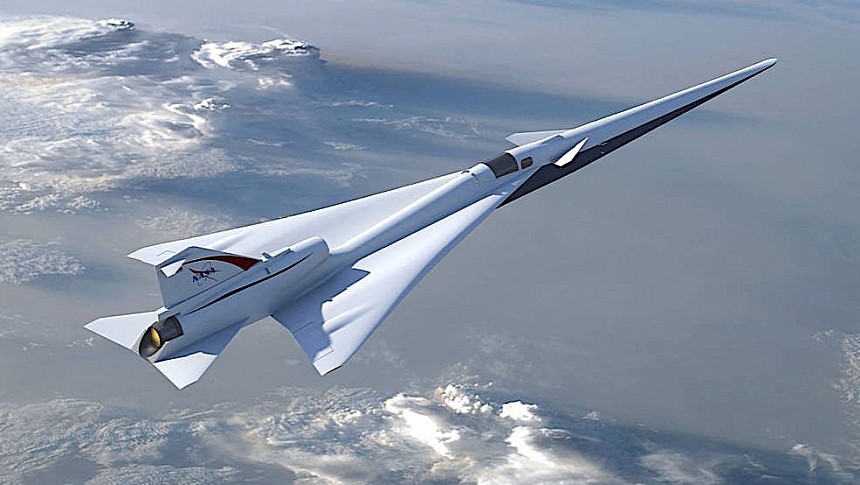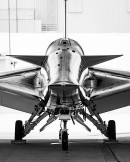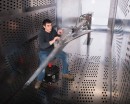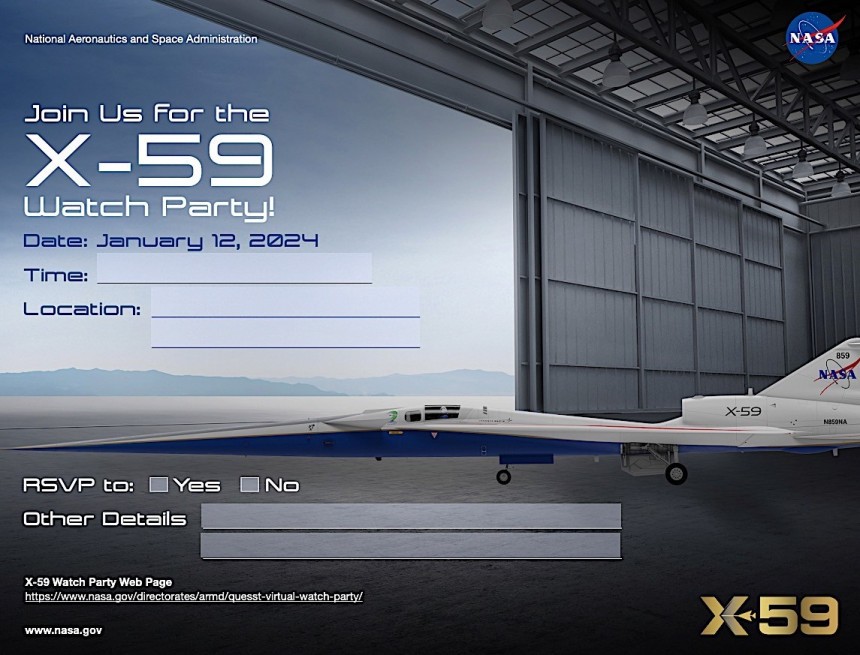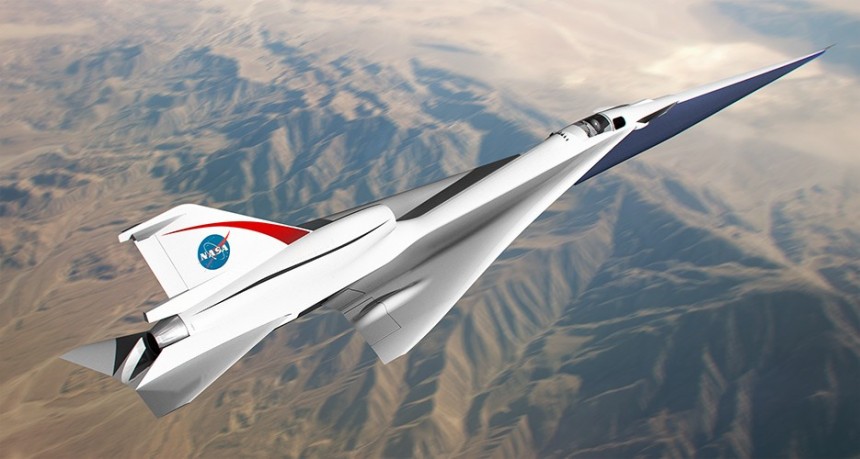It's not every day we simple humans get to witness the birth of a new piece of technology that may change life on Earth, from the initial idea to its first use. Luckily for us living in this day and age, American space agency NASA made that a reality more than once.
Perhaps the most important piece of tech we've seen being taken from idea to application during our lifetime was the Space Launch System rocket of the Artemis program. But we've had others too, including the Perseverance Mars rover, or the James Webb Space telescope.
As we step into 2024 NASA is ready to show the world the result of yet another effort it's been engaged in, one meant to "reduce the sonic boom made by supersonic flight to a sonic thump" and effectively open the doors for civilian supersonic travel to make a return.
The effort is called Quiet SuperSonic Tecnology (QueSST), and we know its result by the name X-59. It's an experimental supersonic aircraft we've covered extensively over the past few years, but one that we haven't actually seen in the form it will fly in the skies over America.
That will change on January 12, when NASA plans to show the plane in all its red, white, and blue glory in front of a world audience for the first time.
To mark the moment the space agency is planning to have as many people as possible watching, kind of like when the entire planet was watching the Moon landing decades ago.
The unveiling of the plane will take place on January 12 starting 4 PM EST, and it will be broadcasted live on NASA's official streaming service, on the NASA app, YouTube, and on the agency's website.
To make sure people are paying attention, NASA is hosting something it calls a watch party. In a nutshell, it encourages everyone to get their friends together and see the unveiling in classrooms, homes, and pretty much anywhere.
To make sure your friends partake in this "historic milestone in aviation history," NASA has created printable invitations, developed a series of STEM-related activities, and even released an X-59 Watch Party Planning Guide (check the attached PDF for more on that).
If you do plan on hosting such a watch party, you can tell NASA about it, and the agency will add the location of your party to a map showing similar gatherings planned for that day all over the world.
The only things the space agency won't be providing for the X-59 rollout party are snacks and refreshments.
The X-59 will be shown on the tarmac of the Lockheed Martin Skunk Works facility in Palmdale, California. By the end of this year, the airplane will take flight over several U.S. communities that are yet to be announced in an attempt to gather data on how people perceive the plane and how the sound it makes affects them.
As you know, supersonic flight over land is not allowed in our world, mostly because of the scary noise of sonic booms. The design of the X-59 will not eliminate them, but has the potential of reducing them significantly to be easily ignored.
The X-59 is a mashup between an original design and parts taken from other planes. For instance, it uses the cockpit of a T-38 Talon trainer aircraft, the landing gear of an F-16, and the life support system of the F-15. The plane is powered by a General Electric turbofan engine rated at 22,000 pounds of thrust.
The thing was designed in such a way as to separate the pressure waves shocks and expansions associated with supersonic flight, which are basically responsible for the sonic booms which occur when going past Mach 1.
According to NASA, the target is to reduce the noise the airplane generates from 78 dB at over 8,000 meters (26,200 feet) to as little as 60 dB. The difference may not seem all that much, but it's the difference between a deafening sound generated by an F-16 going fast and the volume of an average conversation between two friends.
The first flight of the plane was supposed to take place in 2023, but several technical challenges stopped that from happening.
After it flies, the X-59 will not give birth to some new kind of aircraft, but it's meant to inform the industry on design ideas that may one day help a company develop a supersonic aircraft to bring back the bling of the Concorde. Separately, data gathered during test flights will be shared with regulators to help them adjust the rules that presently limit the use of supersonic planes.
The ultimate goal of the entire project is to allow aircraft to go supersonic over populated areas, and that would mean, for instance, you could make the trip from New York going faster than the speed of sound. Wouldn't that be something?
As we step into 2024 NASA is ready to show the world the result of yet another effort it's been engaged in, one meant to "reduce the sonic boom made by supersonic flight to a sonic thump" and effectively open the doors for civilian supersonic travel to make a return.
The effort is called Quiet SuperSonic Tecnology (QueSST), and we know its result by the name X-59. It's an experimental supersonic aircraft we've covered extensively over the past few years, but one that we haven't actually seen in the form it will fly in the skies over America.
That will change on January 12, when NASA plans to show the plane in all its red, white, and blue glory in front of a world audience for the first time.
To mark the moment the space agency is planning to have as many people as possible watching, kind of like when the entire planet was watching the Moon landing decades ago.
The unveiling of the plane will take place on January 12 starting 4 PM EST, and it will be broadcasted live on NASA's official streaming service, on the NASA app, YouTube, and on the agency's website.
To make sure your friends partake in this "historic milestone in aviation history," NASA has created printable invitations, developed a series of STEM-related activities, and even released an X-59 Watch Party Planning Guide (check the attached PDF for more on that).
If you do plan on hosting such a watch party, you can tell NASA about it, and the agency will add the location of your party to a map showing similar gatherings planned for that day all over the world.
The only things the space agency won't be providing for the X-59 rollout party are snacks and refreshments.
The X-59 will be shown on the tarmac of the Lockheed Martin Skunk Works facility in Palmdale, California. By the end of this year, the airplane will take flight over several U.S. communities that are yet to be announced in an attempt to gather data on how people perceive the plane and how the sound it makes affects them.
As you know, supersonic flight over land is not allowed in our world, mostly because of the scary noise of sonic booms. The design of the X-59 will not eliminate them, but has the potential of reducing them significantly to be easily ignored.
The thing was designed in such a way as to separate the pressure waves shocks and expansions associated with supersonic flight, which are basically responsible for the sonic booms which occur when going past Mach 1.
According to NASA, the target is to reduce the noise the airplane generates from 78 dB at over 8,000 meters (26,200 feet) to as little as 60 dB. The difference may not seem all that much, but it's the difference between a deafening sound generated by an F-16 going fast and the volume of an average conversation between two friends.
The first flight of the plane was supposed to take place in 2023, but several technical challenges stopped that from happening.
After it flies, the X-59 will not give birth to some new kind of aircraft, but it's meant to inform the industry on design ideas that may one day help a company develop a supersonic aircraft to bring back the bling of the Concorde. Separately, data gathered during test flights will be shared with regulators to help them adjust the rules that presently limit the use of supersonic planes.
The ultimate goal of the entire project is to allow aircraft to go supersonic over populated areas, and that would mean, for instance, you could make the trip from New York going faster than the speed of sound. Wouldn't that be something?
